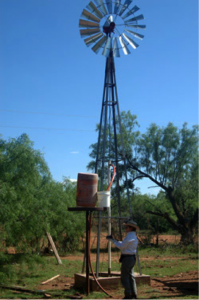Phase II Results
In Phase II the SWP carried out five field pilot tests to validate the most promising sequestration technologies and infrastructure concepts, including three geologic pilot tests and two terrestrial pilot projects. This field testing demonstrated the efficacy of proposed sequestration technologies to reduce or offset greenhouse gas emissions in the region. Risk mitigation, optimization of monitoring, verification, and accounting (MVA) protocols, and effective outreach and communication were additional critical goals of these field validation tests.
The project included geologic pilot tests located in Utah, New Mexico, Texas, and a region-wide terrestrial analysis. Each geologic sequestration test site was intended to include injection of a minimum of ~75,000 tons/year CO2, with minimum injection duration of one year. These pilots represent medium-scale validation tests in sinks that host capacity for possible larger-scale sequestration operations in the future. These validation tests also demonstrated a broad variety of carbon sink targets and multiple value-added benefits, including testing of enhanced oil recovery and sequestration, enhanced coalbed methane production and a geologic sequestration test combined with a local terrestrial sequestration pilot. A regional terrestrial sequestration demonstration was also carried out, with a focus on improved terrestrial MVA methods and reporting approaches specific for the Southwest region. The initial pilot test portfolio is summarized below.
| Pilot Test Location | Type of Pilot(s) | Amount/Duration of CO2 Injection | Key Industry / Govt. Partner(s) |
|---|---|---|---|
| Aneth Field, Paradox basin, Utah | -Deep Saline Reservoir -EOR with sequestration | ~140,000 tons per year for the two year Phae II observation period* | Navajo Nation Oil and Gas Co., Resolute |
| San Juan Basin Coal Fairway, near Navajo City, NM | -ECBM and sequestration -local-scale terrestrial sequestration via riparian restoration | ~18,400 in 378 days | ConocoPhillips , BLM, USDA |
| SACROC Unit, Permian basin, near Snyder, TX | EOR with Sequestration | >170,000 tons/yr into the pilot area, a 40 acre 5-spot pattern.** | Kinder Morgan CO2 Company, L.P. |
| Entire Southwest Region | Regional Terrestrial Analysis | N/A | -USDA |
| * Injection continues as an ongoing EOR Project | |||
| ** Injection continues as an ongoing EOR project, this is ~25% of the injection into the four corner wells into the pattern. Total injection into the four corner wells was ~680,000 tons during the first year or up to 1,360,000 tons during the first two years of injection. | |||
Five of the initial six projects were completed but the deep saline formation injection in the Aneth field was not performed due to technical problems. The EOR portion of Aneth, in a field that had not previously seen any CO2 injection, has proven to be very successful. The SWP partnership set up an MVA protocol before CO2 injection started in the geological field tests. Varying levels of success were found from these tests, which included: repeat VSP, tracer tests in the brine and CO2, passive seismic, repeat surface gas flux, and surface potential. CO2 injection continued through the two-year observation period and is planned to continue at the Aneth field for the foreseeable future.
The San Juan Basin test, in a methane-producing coalbed, has been successful in a number of areas. Injection lasted for just over a year. The injection rate had initial rates of over 200 tons/day but the injectivity soon decreased and after about six months stabilized near 30 tons/day. Thus the total injected was less than expected but is still, to date, the largest injection of CO2 into a coalbed. The associated San Juan Basin riparian restoration project comparing treated and untreated produced water has also shown promise. The MVA tests for the San Juan Basin included: repeat VSP, repeat logging, tiltmeters/GPS, tracer test, water analysis, CO2 sensors, gas sampling, and CO2 surface flux.
The third geological storage project was in the Permian Basin of Texas. Initially plans included a new CO2-EOR project in the Claytonville field with analysis of the SACROC project that has had CO2 injection ongoing since 1972. Because CO2 injection was postponed in Claytonville and was not expected to be initiated before the scheduled end of Phase II, the total emphasis was shifted to SACROC in a pattern that had had some CO2 injection earlier and was being recompleted for new and increased CO2 injection. The MVA program in the SACROC proved to be very instructive. It included: repeat VSP, repeat logging, repeat 3D, extensive water sampling and analysis, and produced fluid sampling.
The final project was a terrestrial CO2-sequestration project, which examined the entire southwest region for terrestrial analysis. This research has identified a number of approaches to have either been proven or show great potential.
Permian Basin, Texas – Enhanced Oil Recovery

Groundwater testing at SACROC Site (Texas)
The Scurry Area Canyon Reef Operations Committee (SACROC) oil field located near Snyder, Texas is the oldest CO2 Enhanced Oil Recovery (EOR) operation in the U.S. Over the past 30 years, about 93 million tons of CO2 have been injected and about 38 million tons have been produced and reinjected. A simple mass balance suggests that the site has accumulated about 55 million tons of CO2.This location was used to validate the CO2measurement, monitoring and verification (MMV) systems that are an important part of the SWP’s field tests.
Download the Final Report (PDF, 17 MB)
